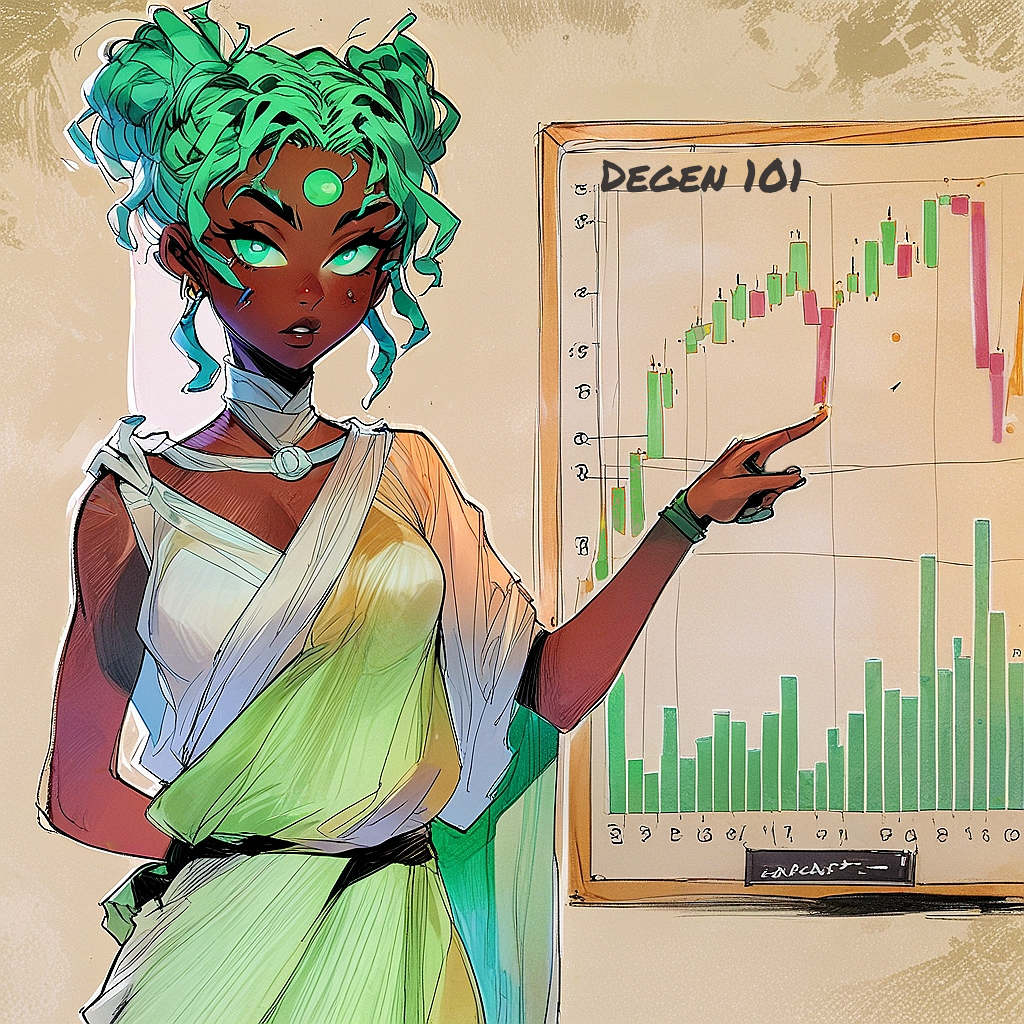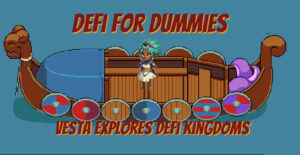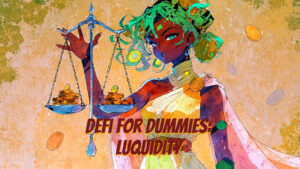This is the first in a series of articles exploring the use of various DeFi protocols operating on the Metis network. In these guides we’ll explore the various options available to Metis users, the potential benefits and risks, and break the process down for you into easy steps. But before all that we thought we should address the question; what is DeFi?
What is Defi?
DeFi is short for “Decentralized Finance”. But what the hell does that mean?
Before we dive into this, you’ll need to understand the basics of how blockchain technology works and its security features. If you’re unfamiliar with these, check out the provided links. We also have an article on Decentralization, but since it can have many meanings, let’s explain it briefly here.
What does “Decentralized” mean?
When we talk about decentralized finance being #decentralized# we mean the following:
-
- Open Access. Any user with a crypto wallet and the relevant coins or tokens can take part. Generally there is no requirement to #dox# yourself.
-
- Trustless. The best DeFi platforms use audited #open-source# code that allows users to trust their transactions will execute as advertised.
-
- Security. DeFi platforms built on well tested networks or changes inherit much of the security and finality from that chain.
However, many DeFi platforms are not decentralized in that:
-
- Single point of failure. Many DeFi platforms are controlled by a single company or team; which tokens can participate in a meaningful way is often decided by the project controllers. Note that even if a DeFi platform has a #governance# token, they often give no meaningful control to their users.
What does “finance” mean?
DeFi is crypto’s answer to the traditional finance system; DeFi apps allow users to enjoy a wide variety of financial services. These include:
-
- Lending crypto to other users in exchange for interest.
-
- Borrowing crypto using their own tokens as collateral.
-
- Swapping crypto coins and tokens for others.
-
- Providing #liquidity# and earning fees. (Check out our Token Metrics article for more on liquidity)
-
- Trade crypto #options# and use #leverage#.
The term DeFi is broadly used. For some it may only cover the above, for others it might include further uses, such as:
-
- Staking tokens in a validator or #sequencer pool#.
-
- Staking tokens in exchange for a share of a project’s dividends.
Advantages of DeFi:
When we talk about advantages (and disadvantages) of DeFi, we are doing so when compared to traditional financial institutions (#TradFi#). Obviously there are many advantages (and disadvantages) to the idea of finance in general; but this article has to end eventually, so they will not be covered here.
Accessibility and Inclusivity
Anyone with an internet connection can participate in DeFi, regardless of their location, financial history, or identity. This open access allows people in underserved regions, or those without access to traditional banking, to use financial services.
#TradFi# often has rules you need to follow before you can open an account or get a loan. You might need to prove a minimum income, prove identification, or live in a region with access to banking infrastructure.
This can exclude large portions of the global population, especially in developing countries.
Transparency (Everything is Open)
In DeFi, all transactions (exchanges of money) are recorded on public blockchains. This means anyone can check the records and see what’s happening. It makes everything open and clear, which helps foster trust in the system.
In traditional banking, most things happen behind closed doors. Customers don’t know all the details about how the bank works or what they’re doing with their money.
Control Over Your Own Money
In DeFi, you hold your money in your own wallet, and you control it yourself. There is no bank or company holding your money for you. You don’t need to ask anyone’s permission to send, save, or borrow money.
In traditional banking, the bank holds your money, and you trust them to manage it safely. You might not have full control if they freeze your account or set limits on what you can do with your money.
This may not sound like something that “affects” you, and you may well be right. However, more and more access to “spending” has been used as a method of control. Recently in Canada, the government froze the bank accounts of protesters as a way to discourage participation in the protests. .
Lower Fees and higher earnings:
Since DeFi removes the need for middlemen by using #smart contracts#, the fees are often lower. For example, if you want to send money overseas, it can be cheaper and faster with DeFi. On #Metis# for instance, transaction fees are often less than $0.01.
Additionally, because there is no middle man, often a higher percentage of the money earned from your use of your funds (for instance through lending), is passed on to the user.
Traditional banks often charge higher fees for things like international transfers or taking out loans, this is especially true for business accounts, who often need to pay for every transaction. They also employ much larger staffs in addition to having multiple brick and mortar locations; this means they pass on less money to the end user (you).
Speed
Transactions in DeFi can happen quickly, often in just a few seconds, because they run on technology that doesn’t need human approval or bank hours. You can send money, borrow, or trade 24/7.
Banks and financial institutions can be slower because they often require approvals or are only open during certain hours. International transactions can take days.
Disadvantages of DeFi
So now that we’ve sold you on the idea of DeFi being the best thing since 2002 Space Western, Firefly, we thought it only appropriate that we tell you the bad too.
Here are some of the ways in which DeFi might be less attractive than #TradFi#.
Regulatory Uncertainty and Lack of Consumer Protection
DeFi operates in a legal gray area in many regions. Regulations are still being developed, and sudden regulatory changes could affect the availability, or legality, of DeFi platforms.
If DeFi was “banned” in your country your government cannot impact your ability to interact with the blockchain, but they could make it very difficult for you to #off-ramp# your funds.
Traditional finance is well-regulated with established legal frameworks. This regulatory environment provides protections for consumers, such as deposit insurance and legal recourse for fraud or disputes.
On top of this crypto has a general lack of consumer protections. If a DeFi project is hacked, scammed, or goes bankrupt, there is ussually no recourse for users.
Consumer protections, like chargeback options on credit cards, fraud detection, and deposit insurance, provide a safety net for #TradFi# users.
We dive into this further in Advantages and Disadvantages of Crypto and How to keep your crypto safe.
Security Risks
DeFi smart contracts, while efficient, can be vulnerable to bugs, hacks, and exploits. Several DeFi protocols have been compromised, resulting in significant losses for users. Since DeFi platforms are not insured, users are at risk of losing their funds permanently.
Additionally, due to the decentralized nature of Crypto, anyone can set up a DeFi platform. There have been countless instances of bad actors creating DeFi platforms in order to steal user funds.
While not immune to hacks, traditional finance offers some level of consumer protection. Banks and financial institutions often offer insurance on deposits (e.g., FDIC insurance in the U.S.) and have fraud prevention mechanisms in place.
For more on this topic we’d recommend checking out our articles on
Advantages and Disadvantages of Crypto – for info on the downside of decentralization
and
How to Keep your Funds Safe – for tips on how to have the best shot of finding DeFi platforms you can trust.
User Responsibility
In Crypto, users are responsible for securing their own private keys, wallets, and funds. If they lose their private keys, there’s no way to recover their assets. Additionally, interacting with DeFi platforms can be complex, requiring a deep understanding of blockchain, wallets, and protocols.
In traditional finance, banks and financial institutions manage security and provide user support. If you lose access to your account or make a mistake, customer service can assist in recovery or dispute resolution.
We cover this a lot more in Advantages and Disadvantages of Crypto and Crypto and Blockchain: Is it Safe?
Volatility and Risk
DeFi: Many DeFi platforms are built on volatile cryptocurrencies, which can lead to large fluctuations in asset value. Even stablecoins, which aim to maintain a fixed value, are not immune to risks like de-pegging or failure of the issuing entity.
While TradFi has its risks, especially in the case of economic downturns, fiat currencies tend to be more stable than cryptocurrencies. Investments like bonds and savings accounts are usually much less volatile.




